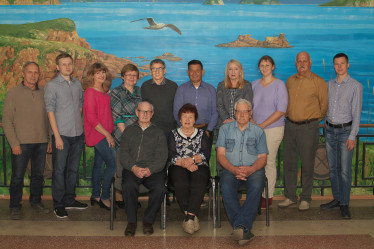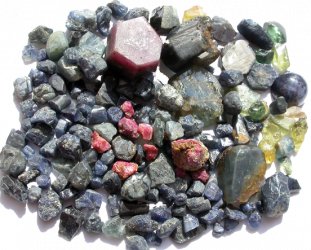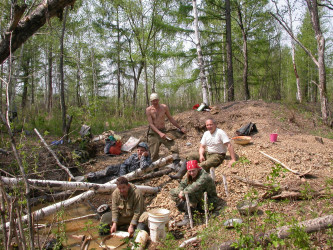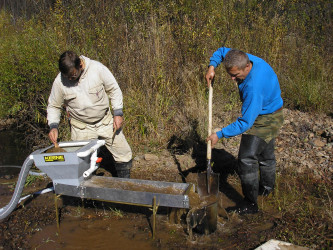Department of Petrology and Mineralogy
Laboratory of Genetic Mineralogy and Petrology
Head of the Department and the Laboratory, Prof. Sergey V. VYSOTSKIY
Tel. +7-(243)-2318-750
E-mail: This email address is being protected from spambots. You need JavaScript enabled to view it.
 |
The Laboratory of Genetic Mineralogy and Petrology was created in 2017 as a result of incorporation of three laboratories – the Laboratory of Mineralogy (headed one after another by S.A. Shcheka (1971–1999) and S.V. Vysotsky (1999–2017)), the Laboratory of Physical and Chemical Petrology (headed by A.A. Marakushev (1959–1964), S.S. Zimin (1964–1968), M.A. Mishkin (1968–1996), and O.V. Avchenko (1996–2017), and the Laboratory of Petrology and Volcanic Belts (headed by: V.G. Sakhno (1975–2002, 2013–2017), V.K. Popov (2002–2007), and V.F. Polin (2007–2013)). In 2012 the Laboratory of Mineralogy incorporated the Laboratory of Experimental Mineralogy (laboratory’s heads: G.G. Likhoydov (1991–2006) and L.P. Plyusnina (2006–2012). A large amount of empirical data on specifics of the Far Eastern ore deposits and magmatic complexes was collected during these years. That was the time of scientific works by E.A. Radkevich, L.N. Khetchikov, I.N. Govorov, A.A. Marakushev, I.Ya. Nekrasov, S.A. Shcheka, M.A. Mishkin, O.V. Avchenko, V.V. Ivanov, S.V. Vysotsky, V.G. Sakhno, R.A. Oktyabrsky, V.T. Kazachenko, T. Ya. Gulyaeva, V.P. Zevereva, and others concerning many issues of the mineralogy of tin ore, polymetallic, REM and boron deposits, to the paragenetic analysis of metamorphic and metasomatic rocks throughout the Far East. The Institute is equipped with modern precision and high-production analytic apparatus which allowed the scientists to fully use the mineralogical method and broaden the list of new and rare varieties of metals including
the platinoids.
 |
At present 18 laboratory’s scientists, comprising 5 Doctors and 8 Candidates of Sciences, carry out research in the following fields of study:
- Comparative mineralogy and geochemistry of the abyssal rocks of the Earth’s crust as well as reconstruction of the mineralization conditions based on the ratio of stable isotopes;
- Petrogenesis of the magmatic complexes forming the Eurasian margin crust in East Asia, and productive for large noble metal mineralizations;
- Reconstruction of the physical and chemical conditions and fluid regime of the formation of igneous and metamorphic complexes by the means of mathematical modeling;
- Mineralogy and physicochemical properties of the crystallization conditions of alkaline and granitic rocks in the zones of the Late Mesozoic tectonic and magmatic intensification of the Aldan Shield;
- Age dating and defining sources of granitoids from the eastern part of Central Asian Fold Belt.
 |
 |
Within this scope the reconstruction of the conditions and processes of mineral and ore genesis is carried out. The most important achievements of the last years were made during the investigations of Mesoarchean massive sulfide ores. This research revealed that sulfur isotopic composition correlates with typomorphic features of sulfides and their composition, bearing witness of sedimentary S playing a significant role in the massive sulfide ore genesis. For the first time in the sedimentary interlayers of Mesoarchean sulfide ore occurrences of Karelia the presence of ancient mineralized biologic remains – silicate coccoids, pyrite-arcasite spheroids and hollow pipes – was uncovered. These facts confirm the supposition that 3.5 billion years ago in the Archean the life was relatively widespread and developed, while among the primitive organisms certain species actively influenced the processes of ore formation. We were the first to describe the composition and geochemical characteristics of the early sialic crust of the Archean cratons and Paleo-Proterozoic fold regions on the basis of the concept of mantle plumes. It was established that the plume magmatism in the Archean first led to the formation of primary komatiite-basalt crust that melted during the subsequent impulses of the plume formation, thus creating the primitive intermediate melts of the early sialic crust which laid the foundation of the Archean cratons. For the first time the geochemistry of the volcanic glass from the primary sources and archaeological sites in the Far East was studied. It was revealed that obsidian played such an important role that ancient people would walk as far as hundreds of kilometers in order to collect this material for tool making. In the last decades the workers of the Laboratory of Mineralogy uncovered diamonds and sapphires first in the placers and then in the bedrocks in Primorye. The study of the diamonds has shown the traces of a repeated recrystallization, dissolution and crushing, and that they are confined to alkaline ultrabasic volcanic pipes. A new formation model has been proposed for carbonado, a fine-grained aggregate of diamonds, which suggests the recrystallization of monocrystals. The Primorye sapphires’ genetic relation to the alkali basalt-producing volcanos was demonstrated. Also, mineralogical and geochemical indicators of sapphire mineralization were determined. The research of the nanostructures of opals, diamonds, and sapphires is has established that hydrothermal opals lack for structuredness of nanoparticles typical of exogenic opals.
The laboratory’s scientists work closely with the Institute of Earth’s Crust and Vinogradov Institute of Geochemistry SB RAS (both in Irkutsk), the Institute of Volcanology FEB RAS (Petropavlovsk), Institute of Geology KarRC RAS (Petrozavodsk), and production organizations of the Russian Far East. These institutions participate in many international scientific expeditions undertaken on the territory of Mongolia, China, Japan and in water areas of the marginal seas of the Pacific Ocean. Under the Agreements on joint scientific activity with the Chinese and Japanese colleagues the investigations of the metalliferous carbonaceous rocks as well as of the obsidian geology and archaeology are conducted on the territories of the Russian Far East and Northwestern Asia.

